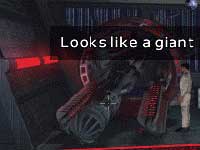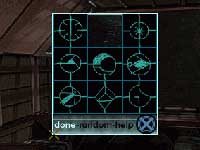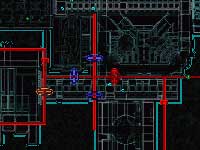The Resurgence of Miss Point-and-Click
While major American (and British) game magazines have declared at least the point-and-click adventure, if not the entire adventure game genre, dead, the clocks tick a little differently in Croatia.
From developer Fragile Bits Interactive and publisher OnDeck Interactive (a division of G.O.D. Games) comes a 2D/3D point-and-click adventure called "The Ward."
Installation is fairly painless using a self-written installer, and the minimum weighs in at only 113 megabytes, a relief for stressed hard drives. Nice: you can change between four install sizes, which range from 113 MB to just over 1 GB, on the fly without losing your saved games. And the game has a minimum specification of "Pentium/133 with 32 MB RAM" -- do people even remember these relics?
One pet peeve of mine: the installation makes a group in your Start menu without asking. Grr.
Now here's a new one, folks: when you start the game and click on "NEW", you are presented with three choices:
- EASY, which lets you skip major logical puzzles with the click of a button, and makes other puzzles easier,
- NORMAL and
- DEMO, which is an unique mode that will play through the first bit of the game for you. At any point, you can hit ESCAPE and take over, or advance the action to the next puzzle with the space bar. This can basically be used as a walkthrough for the first bit (the sparse manual also provides hints for several puzzles, but apart from that, you're on your own).
Graphically, the game is not a masterpiece of 3D-enhanced proportions (as the minimum specs might have told you), but for a team this small (six persons conceived and wrote the game) from a country the new US president has probably never heard of, the effort is very impressive indeed.
The Backstory
As the manual points out, a ward is both a person placed under protective custody and a person appointed as a custodian -- and indeed, the player starts out wearing a necklace he can't remove.
But I'm moving too fast -- the game has a backstory, too, told in rendered video sequences without lip synching. You can tell the voice acting was not exactly done by professionals, but it's worlds away from some of the "drunk company janitor" voiceovers I've heard in other games. During the actual game, there aren't any voiceovers, just music and sound effects.
I digress again. Anyway, your name is David Walker, one of three astronauts in the Apollo XIX mission to the moon. On a normal day of collecting information on seismic activity, everything suddenly goes wrong as your crew members are killed by an invisible force; there is a green pulsating light; and suddenly, you are elsewhere.
In fact, it seems you have been abducted by aliens and are wearing the aforementioned necklace. Your first task is escaping from your prison -- some mysterious explosion has already blasted open the doors -- and finding out where all the dead aliens come from and who is attacking them; and the fact that all the computer screens are in Alien doesn't help too much.
Over the course of the game, especially in the conversation-heavy second part, you'll find out the secret behind your abduction and the origins of the Ward.
The plot designer wrote several pieces for a local science fiction magazine, and he is obviously also a fan of the genre; the story resembles such classics as the Brothers Strugatzkij's "Roadside Picnic" (probably virtually unknown in the United States -- think the Heechee artifacts from Frederick Pohl's Gateway, except more inexplicable) but also draws heavily from modern-day myths cannibalized in the first few seasons of the X-Files (UFO abductions, the "Greys", Men in Black, government conspiracies, ...)
The puzzles
This is definitely not an adventure game for beginners. There are two or three easy puzzles at the beginning, including a Mastermind clone, but you soon find yourself manipulating screens, watching drones, abusing robots, sending codes and trying to not get killed all at the same time.
It is lots of fun trying to figure out all the nifty gadgets in the first part of the game, and very rewarding when you finally do. The puzzles in this part are completely logical, and one even contains on-line hints that pop up every minute or so -- but only if you are actively trying to solve it.
While the first part of the game, in which you try to escape from the Alien Moon base, is hard sci-fi and puzzle solving, the second part is very much different.
Set on a Mars base, the second part introduces a large cast of characters and turns into a whodunit-meets-X-Files; there are lots of subjects to talk about while you uncover the aliens' interest in the abductees, why the base is run like a prison-camp by humans without an alien in sight and the mystery behind the things hinted at in the first part. Apart from that, you'll have to deal with mysterious disappearances, attempts on your life, revolutions and, of course, escape.
Unfortunately, the puzzles in this part of the game consist of the big no-nos in adventure gaming, featuring not one but five sliding puzzles and a game of blackjack. Okay, so the sliding puzzles are only 3x3 and really easy to figure out, and blackjack isn't that hard once you understand that the game will prevent anyone losing their last stake at any cost, but if the sheer mention of "slid..." gives you screaming fits, stay away from the game -- or play the easy version, which lets you skip them with a click of the mouse.
The last part is completely different again. I don't want to spoil too much here, so I'll just say that there's more action-packed plot as you discover the full extent of the aliens' plans and lead Earth into a safe future -- if you manage to survive.
What about the interface?
The interface is pretty straightforward. Left-clicking interacts with the environment, picks up things from the inventory or drags-and-drops close-up views, the status bar or the inventory. Right-clicking opens and closes your inventory (if it isn't in freeze mode) or puts an item away; it may have other functions in puzzles.
There is, however, one thing to look out for, since I thought I had gotten stuck on a puzzle and ended up replaying one section near the start for hours: holding down the left mouse button for a longer time works differently from just clicking it. This is not documented anywhere and I ended up trying it out of sheer exasperation. Imagine my surprise (and slight annoyedness) when it worked.
Other nifty features include quick-save and quick-load hotspots in the top left and right screen corners -- they keep four quicksaved games before the oldest one is overwritten and quick-load restores the most recent game automatically, even if you've saved manually in slots 5 to 9999.
In the heat of the battle, so to speak, I once accidentally loaded a save-game from the very beginning of the game and had to replay a lengthy section, so be careful.
Enough babbling, how was the game?
All in all, I enjoyed it. The practice of not having voice-overs during the game makes the haunting (but quickly repetitive, especially if you get stuck for a longer time) music and sound effects that more effective. And besides, I am a very impatient guy -- I usually turn on voice and text in every game and skip over parts of the dialog, just skimming the text. And some of the conversations in this game are very long -- "Do you want the brief, CNN-style show'n'tell, or the longer, painfully yet pleasurably detailed Joycian kind of thing?" asks one of the characters before launching into an explanation of Planescape: Torment proportions.
You can die in the game, and there are a few sequences that are critical to timing, but there is no way to render the game unwinnable. I'd advise you to save often, since these sequences mostly come without warning and you usually die at least once. If you find yourself seemingly stuck in the second part, try and track down everyone and talk to them about everything -- it's sometimes needed to advance the plot.
One interesting thing is the handling of characters in the second part of the game. Instead of walking people in and out of rooms, the designers chose to "teleport" them from room to room -- people turn into octagonal outlines and quickly move through an exit. With all the walking around I had to do in order to find all the people I needed to talk to and then get them to places where they would talk to me, I quickly wished my character could do the same.
The only real technical problem I had was the game crashing when I tried to run the videos in true-color mode, but this might be due to the fact I ran the game on a laptop in Windows 2000. Apart from that, and a few typos ("Appolo" being the most obvious), it runs smoothly and bug-free.
If you liked playing with the neat gadgets in Andrew Plotkin's Spider and Web and/or science fiction stories, you will not be disappointed by this game -- if you can stand solving several sliding puzzles in a row, that is.
Test system:
Mobile P3/500 with running Windows 2000
128 MB RAM
ATI 3D Rage LT Pro
ALS300 sound card
This article copyright © 2001, Gunther Schmidl




